Media | Articles
In the Oldsmobile Cutlass, Rocket-powered muscle collided with Malaise engineering
The early 1970s was a tough time for Detroit automakers. Amid the demise of the muscle car and the fuel crisis, glimmers of future brilliance shone through. There were major advancements in the areas of plastics engineering, computer-assisted design, and an increased usage of aluminum. Catalytic converters and other emission technology vastly improved urban air quality. Was 1973 the beginning of the end for American performance? Maybe, but the realities of the world forced car companies to think in new ways.
Emissions and safety ruled the roost in ’73, and we should be clear that the effects were disquieting. Bigger bumpers added weight in the wrong place (i.e. more mass at the end of the nose hurts handling), and emissions restrictions sapped engines of power output. It would take a decade for the benefits of new technology to enter the market (looking at you, 1982 Mustang GT) but there was a lot of simmering potential. Much of it appeared in the Oldsmobile Cutlass.
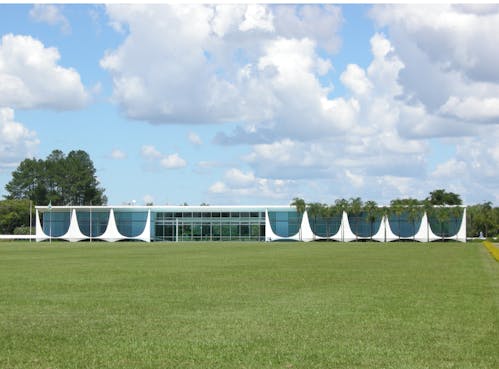
GM’s A-body platform and its various sedans, wagons, and “Colonnade” coupes (like the Cutlass) were extremely innovative. Colonnade is an architectural term referring to a series of pillars connecting a sleek roof, placed in harmony and providing a dramatic effect that couldn’t be replicated otherwise. General Motors had previously designed cars with A-, B-, and C-pillars (or sometimes a hardtop with no B-pillar), but the 1973 Colonnade cars employed just an A and a B. The big innovation was the revival of the classic Opera Window, albeit in newly radical form. The Colonnade cars were, after all, rather theatrical in the realm of hardtop styling.
The Cutlass’ styling creativity didn’t end there, as the mandated larger bumpers were cleverly finessed into the body. It was one of a few vehicles of the era with a spring-loaded grille, saving itself from a hydraulically-assisted front bumper, and for 1973 it boasted a pair of them. Note how designers wrapped them both down over the front fascia to continue the hood’s long lines. Details like this support the thesis that GM design superiority in this era remained in full force—all the more impressive given that it was the Feds dictating many of their changes.
If they had to be bigger and heavier, at least the styling could be bolder. GM designers got more comfortable with attention-seeking looks, leaning into the national discotheque that was the 1970s. Ford’s 1973 Torino/Montego twins would have killed for such an impressive upgrade, as their legally-mandated implementation was downright dowdy.
Marketplace
Buy and sell classics with confidence
Changes under the skin make the Colonnade cars appealing, too. The most appealing of all 1973 Cutlass Colonnades was the Olds 4-4-2 and the Hurst/Olds. While more of a grand tourer compared to predecessor versions, these souped-up Cutlasses sported a handling package, unique trim, and a few engine choices: a 350-cu-in V-8 and a pair of 455-cu-in big blocks with either 250 or 270 (SAE net) horsepower. The latter was available with a four-speed manual, and it was the last year of a stick shift Hurst model. (The 4-4-2 came with downright revolutionary five-speed manual just four years later.)

Here’s where I’ll point out that the A-body benefitted from some serious Malaise-Era modernization. The implementation of steel-belted radial tires for higher-trim Colonnade coupes demanded significant refinements to the platform’s suspension design, which had long-reaching consequences in the GM lineup. Even better, all A-bodies for 1973 have suspension component interchangeability with the highly regarded B-body that came out in ’77, which makes them an underrated delight for modern hot-rodders. So yes, a ’73 Cutlass can take full advantage of the same aftermarket/OEM-plus upgrades available as the 9C1 Caprice and 1994–96 Impala SS.
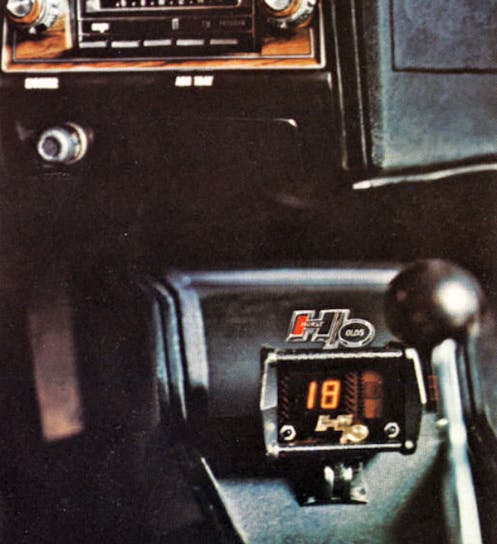
One of the coolest tricks available for 1973 was the Hurst/Old’s optional digital tachometer. Unless you worked at NASA, computerized displays in your console were beyond rare in the early 1970s, not becoming an optional feature in Lincolns (Continental Mark V fuel computer) and Cadillacs (Seville trip computer) until the latter part of the decade. Hurst’s implementation measures engine revolutions in hundreds of rpm, providing granular data that will likely appeal to the most fanatical engine tuners of the time.
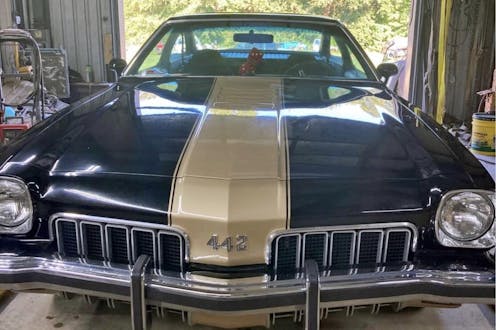
The W-30 model soldiered on for 1973, but thanks to ever-tightening emissions controls, it faded into more of a trim package. If the aesthetics still do it for you, then check out the W-30 1973 Olds 4-4-2 we found posted on Hagerty Marketplace. It’s finished in black and gold and sporting a Hurst automatic shifter to add more appeal to an already rare ride from GM’s rocket brand. (No, it isn’t a Hurst/Olds as it lacks those specific cosmetic upgrades.) The only thing more appealing would be an example with the 4-speed manual, but some of us prefer an automatic anyway.

This particular example comes with the cloth seats (which swivel for easier entry/exit), and looks to present the upgraded Cutlass “S” interior trim surrounding the Hurst-equipped goodness. The seller states this example has a pop-up roof, cold A/C, and it runs strong. The $21,500 asking price may raise some eyebrows, but that’s in line with our prices in our valuation tool for a similarly-equipped Cutlass Supreme in #2 (excellent) condition.
For anyone who enjoys a good Olds, an obscure example of the breed like this is pretty special. Hopefully, if you didn’t already, you have as much appreciation for the engineering and design efforts of this era as we do. With the 1973 Cutlass, 4-4-2 (and the Hurst/Olds), GM truly made a sweet, sweet lemonade from bitter lemons.



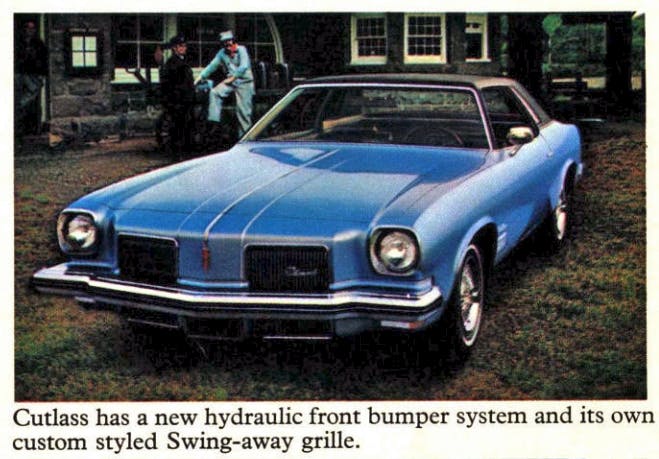












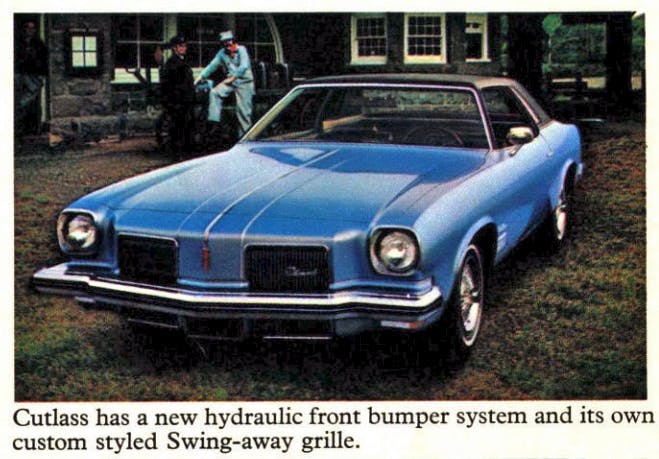






70s Cutlasses are among the best of the decade in my view. Sales backed that up too.
I have long felt that GM should revive the model as a Chev, but do a campaign of people reflecting on “my father’s, grandmother’s, etc. Cutlass” as a cheeky riff on that terrible olds campaign (that was negative towards the past) and make the spin that legacy lives on, Olds is gone but Chevrolet remembers and will carry the torch…
Done right, it would be a great long-form superbowl launch. Besides, the marketplace is dying for retro boxy era as that hasn’t really been done and everything is smoothy jelly blob.
The Chevy Cutlass? Mmmm… I don’t know about that. Chevy discontinued the Impala, which was a nice family car. More recently, Chevy announced the discontinuance of the Malibu, another nice family car. If Chevy no longer will be making these models, long staples in their line up, I really don’t see a Chevy Cutlass being made. But along your line of thought, had Oldsmobile never discontinued its popular models such as the Cutlass, Eighty Eight, and Ninety Eight, perhaps they would have maintained enough market share that GM wouldn’t have deep sixed the Oldsmobile brand. But we will never really know about that.
Two brothers at my high school (a year apart, not twins) had a pair of Hurst Olds, with all of the toys. Including, as I recall, the first use of the Hurst T-Tops. One white, one black, otherwise identical. With the big carb 455, these still had serious torque, even with all of the smog attachments. Great looking, big cars. But, I never really warmed up to the super padded vinyl 1/2 top, seemed like a odd afterthought.
The cars of this era were a mess. But we were excited at the changes till we knew better.
The Olds benefitted by an engine that would nearly run for ever but the bodies on these cars tended to rust our in a couple years. My Moms Malibu was use up by 76-77. Rust at the bottom of the doors.
Many people today either don’t know of forgot how bad things were. GM cars were some of the better as there was many worse.
To buy and restore a car like this today is near impossible, The value is just not there to offset the cost. To find parts is damn near impossible.
This car is not worth $21K to me but I am sure it will be to someone.
I recall an interesting 442 I drove once. I got in and found a 5 speed shifter in a 75-76 442. I got out and looked under the hood as I had never seen one like this before nor since. Under the hood I found a 260 Olds engine. A very rare and odd combination and it was a clean car but then again it was 1979 when I drove it.
If you had a car in this era I am sure there is some interest but general market interest will not ever get to high outside the TA, Camaro, Corvette, LR Truck and some Mustangs.
The trucks and Blazers will rule the way here as they can be restored easy and they are where the market is at today. Blazers are really taking off and will continue to do so.
A 76-77 442 with a 260 V8? The 78-79 Cutlass Salon had a 442, not available in California. It was stock with a 260, 2bbl V8 and a 5 speed stick. The tranny was why it was not sold in California. I own a 78 Cutlass Salon coupe with the 260 V8 and an automatic. Better than the Buick V6 which was really anemic. I had the Buick counterpart, 78 Century with the V6. Nice car but really underpowered.
My cousin had a 1978 (?) Cutlass with the 260, and it topped out at about 80. I presume it was tuned correctly. The 260 has a bad rep in Olds circles, even today.
I had a ’79 Old Cutlass with the 260V8 (this would be in 1983 so it was just 4 years old). Probably the most beautiful car I ever owned. Two toned with a midnight metallic blue top and a silver metallic bottom. Blue/grey interior with bucket seats and a console. The engine was a “dog”. I wouldn’t get out of it’s own way. Best looking car with the worst engine I ever owned. Traded it even for a ’78 Camaro.
I agree.
Malaise era cars are best left to the memories and what could have been.
I have owned many more than I wish to remember and none were exceptionally good. A few were okay.
Hyperv6 is correct. The steel was lower quality and thinner, it wasn’t well treated to save costs, the 70s has a mini-ice age (they now call it) with greater snowfall and thus salt and rust. So many cars of this era had 2×6 bumpers after a few years because the original one rusted off, there were no good used ones available, and GM sold out of repair parts and didn’t make more.
GM flat pellet cats were terrible. Rather than add 2 cats and have some level of performance, these choked engines would struggle through the factory cat, only to be cut off in most places without smog checks.
Radial Tuned Suspension was great, until the Firestone 500 incident.
1977 for big cars and 78 for the intermediates was a huge leap forward in quality, safety, build quality, even if the venerable inline 6 went away.
The X-body Citation demonstrated the Malaise era product managers didn’t learn.
I like the Malaise era cars, I just don’t want one ever again. Sorry, not sorry.
TAs of the era are easy to restore with lots of parts and bring way more than $20k. Trucks not so much. Also Olds didn’t had the rust problem of Chevy as they were better prepared. Have owned many starting back in early 60’s rust was never any more a problem than today.
I had 3 70s era Cutlass colonnade coupes. One was better looking than the other but performance was less than anemic at 10-14 mpg!
An interesting car but not one I would pay much money on. The hurst looks decent.
I think this is the fascinating juxtaposition of 1970’s, smog-era musclecars: Unless it’s a Mustang II or a Chevelle, they’re going to dust or rust away or into the mists of history because they’re never going to be anything more than a historical footnote of what came after the ‘real’ musclecar era…but also before the 1980’s and 1990’s, when it became entirely possible to combine muscle and pony car into a practical daily driver, with the Fox body Mustang hatchback being the ruler of this particular era.
That also might be why the 1970’s smogger cars will eventually disappear, with very few people mourning their loss, they were surpassed on either side of their decade of existence by superior machinery.
Even worse? The 1970’s is also first real widespread test of plastic interior surface material…and the beginning salvo in the war against ‘forever’ cars.
I had a 73 cutlass supreme. It had the four spoke sport steering wheel, AM/FM 8-/track, Heavy duty suspension which was like a $20 option?? which included a rear sway bar and 14 x 7 super stock II wheels. I believe the AM/FM eight – track was about a $400 option. Also had bucket seats and a rally pack. 350 4-barrel I…..believe it had a whopping 180 horsepower.
Muscle Car? Yeah, no. The author should know better (and he’s not the only auto-journalist these days who gets this wrong).
Nothing Detroit put out during the disco/malaise era qualifies as a real muscle car. Period. These were all about image and comfort, with performance or sporting pretensions proclaimed by loud graphics, T-tops, and white letter tires, but very little real performance.
So, please, cool (kinda) as it is, quit calling cars like this 442 a “muscle car.”
I do know better, but the traditional definition just seems to hold no water these days. Fox bodies are muscle cars. Any new Mustang or Camaro is a muscle car. I even heard someone call a HEMI-powered Jeep Grand Cherokee a muscle car. Since this is the world we live in, a Cutlass with a big block 445 is also a muscle car, malaise era or not.
absolutely correct – thank you.
I remember these cars everywhere during my 70’s-80’s youth. They were particularly popular with the metal head dudes who loved to extoll the virtues of the “Rocket-350”. You’d often see then in chocolate brown with RWL tires on matching brown Olds rally whees-adorned with Metallica and Iron Maiden stickers. I thought they were pretty cool at the time.
Good article, but I am getting very tired of hearing the term “Malaise era”. I go to many car shows every year and have been for many years and have never heard car enthusiasts use that term. I think it is just a fancy derogative phrase that auto journalists made up to try to sound like they know everything about cars. I have owned my ’85 Mustang since new and there is nothing Malaise about it. It only has 210 HP but is still a lot of fun to drive.
Your 1985 Mustang is after the Malaise Era, as per the journalist that coined the phrase. Anyone who claims your car fits into that era is very much incorrect.
I agree — the term “malaise era” seems to be just a derogatory term conveniently applied by folks that probably didn’t live through that era or at least weren’t buying new cars then. I bought several new cars during the so-called “malaise era” and have fond memories of most of them. They may have had some performance challenges, but were on the whole decent cars.
By 1985, the Malaise era was mostly over. It mainly refers to cars with large cube V8 engines that had incredibly low power outputs….like 145 hp or less out of a 350 V8. The Mustang GT was one of the first cars to bring back real performance in 1982, and by 85, the 210 hp in your car was a clear sign Detroit was back.
Despite what commenters say, I enjoy reading about those few small hints of performance that carried through to the Seventies malaise era.
I have a 1974 Grand Am and a 2009 G8. I love the drivability and the looks of the G8. I still the think the 74 Grand Am is a better looking car, but the drivability of the Grand Am is severely lacking compared to the G8. How amazing the Grand Am would be if it had the build quality of the G8.
I had a 1973 Cutlass Supreme, black paint, red cloth (bench seat!) interior, landau top, 350, 4bbl, 4spd!! It was rare, cool, and it took my new bride and I back and forth many times from WI to Ft. Riley, KS where I was stationed in the Army. Sold it to a friend, and I’ve never seen another one since!!! Even in the Malaise Era, unusual was cool!
Regarding “malaise era”: As a participant in that period I had a new ‘73 Olds, a new ‘76 Buick and a new ‘78 Plymouth. Each bought in sequence and each earnestly rusting within 2-3 years (and with sagging doors.)
Felt like malaise to me.
In 1977 off the lot of a Buick dealer I bought a 1975 Cutlass Salon. Big block 455 with a Websco electric sunroof. This car was loaded with everything, PW, PB, PW, locks, trunk release, all gauges, auto temp control, cruise, console and the biggest bucket seats! Oddly it had Pontiac Honeycomb wheels and a painted white and silver stripe on the hood and roof. Loved that car and had it until 1993 when I replaced it with a BMW 633csi which I still have. The Cutlass Salon was a dark blue with white interior and white half vinyl top. Really a stunning car and at 100 mph it still had a passing gear! With the salon package it handled fairly well. Miss it!!
This is so interesting Keith! My first car is a 1974 Cutlass Supreme which I still own today. I also have a BMW 635csi that I have owned since the early 1990’s, and I love both cars. Would not replace either of them as they are both enjoyable to drive, and both get tons of compliments every time I take them out. My feeling is if you enjoy what you own, that’s the most important thing. Cars are unique and are a part of who we are. Enjoy whatever it is that gets you excited when you turn the key!
Okay lets call it the Disco era instead. This is another GM goggle eyed tank that tries to graft a Camaro face on for ‘sporty’ look. Compacts became mid size, Mid size like this Cutlass, weighed like ’88s of not many years before. You can hear them rust and dashes crack. All the Big 3 were guilty. I had moved on to Saab 99s at this point-properly engineered, nimble cars that made Detroit products look like polyester bell bottoms.